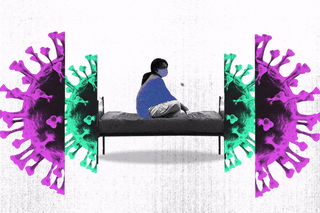
How the Covid19 Pandemic Worsened Tuberculosis Care for Women
The pandemic changed the nature of tuberculosis treatment for women – as gendered barriers relating to stigma and mobility worsened during the lockdown.

There are more tablets, shabbily piled on a shelf in Savita’s home, than there is food in her fridge. “You can’t skip a dose,” the 31-year-old tells me with exhaustion on her face, loyally reiterating the words of her doctor at the public dawakhana some 16 kms away.
Savita was first diagnosed with Drug-Resistant Tuberculosis in 2008, some 14 years ago. A few months before the Covid19 pandemic, her husband left her to get remarried, refusing to pay for her care any longer. The stigma of the disease meant her family too didn’t want her to come back to their village in Konkan. Soon under the shadow of the lockdown, Savita found herself in a one-room chawl in Mumbai’s Sasmira area, with neither the finances to take care of her needs nor the ability to travel for healthcare.
“I am all alone,” she says. “It gets terribly lonely sometimes.”
***
Overall efforts to test, diagnose, and offer treatment to tuberculosis (TB) patients drastically fell as Covid19, which also weakens the lungs, strengthened its hold in the country. Experts note there may be as much as an 80% drop in overall diagnosis, leading to worries of the pandemic causing a long-lasting increase in TB burden.
However, for many women like Savita, the isolation, greater food insecurity, limited financial resources, and travel restrictions brought about by the lockdown have severed an already fraught relationship with healthcare.
Although TB has always been a women’s health issue, it has historically never been afforded a gendered lens. One of the main reasons behind this oversight is the false idea that TB is a “man’s disease,” because global trends have always reflected a higher caseload among men. Anupama Srinivasan, assistant director of REACH, an NGO aiding tuberculosis survivors, also lists the gendered roles and responsibilities that unfetteredly allow the idea of TB as a man’s disease to prevail. Men work in more polluted and intensive fields like factories; men are more likely to smoke and drink, further compromising their lung capacity. “The tendency is to think that because all of these groups are primarily more vulnerable, TB is very much a male disease,” she says.
But this is due to the fact that stigma and lack of access to resources preclude women from opportunities to get tested, directly impacting the chances of them ever getting a diagnosis. TB treatment then becomes a “number game,” according to Ramya Ananthakrishnan, co-founder of REACH. In other words, the numbers are skewed in favor of those who get tested and are thus diagnosed more.
Related on The Swaddle:
Tuberculosis Cases Among Women May Have Increased During Covid19 Lockdown
Further, “when you say it’s a man’s disease, you automatically exclude children and women who are heavily affected by TB,” explains Leena Menghaney, a public health lawyer and regional adviser at Médecins Sans Frontières. A report by REACH also noted: “Although more men are affected by TB, women experience the disease differently, and gender disparities play a significant role in how men and women access healthcare in the public and private sectors.”
Outside the numbers, framing TB as a problem more severe in one gender creates an “index of suspicion” much lower for women, says Anupama. “If a woman with a cough goes to a chest physician or a general physician, chances are the woman would be first tested for various other diseases before TB is identified as a possible diagnosis,” she adds.
Patriarchal norms, now compounded with greater malnourishment and exposure to infection, could have acted as risk multipliers for women during a public health crisis like the pandemic. The focus then needs to be on the complicated and specific ways in which the disease impact women in the aftermath of the pandemic.
During the lockdown, “as per our observations, most of the women infected with TB recently were taking care of active patients in their houses and ended up infecting themselves,” Dr. Pranita Tipre of the BMC told Times of India. This matches with anecdotal evidence. Ramya Ananthakrishnan, the co-founder of REACH, notes: “What we heard from a couple of patients is that if someone had two men in the family, the women actually stayed home to take care of the rest of the family. And they didn’t seek care for their mild symptoms or get scanned – for both Covid19 and TB.”
In other words, as the primary caregivers, women were more exposed to the infection when patients avoided visiting hospitals. 31-year-old Sangeeta*, who contracted TB during the pandemic from her father-in-law, told Devex that as the only daughter-in-law in the house, “the entire responsibility” was on her.
Much of this behavior is rooted in patriarchal norms. Leena believes the gender barriers to TB care are entrenched in the very healthcare system. “Women generally, and if you look at India, are very late to access care and treatment for any disease. You will see this trend in cervical cancer, in HIV, and even in TB – the trend is that the disease progresses significantly before women actually seek care,” she explains.
Leena too knows of many women who prioritized their family’s needs and neglected their health. It aligns with a male bias in families where women’s health is deprioritized. A 2018 study found that male patients with TB expected their wives to care for them but infected wives rarely received care.
Women suffer disproportionately when it comes to any disease, Mira Yadav, 34, says, but the politics of care and isolation make TB a debilitating experience. Mira is a TB survivor who now works to raise awareness about symptoms and help other women.
Experts at the MSF clinic tell me of the heightened stigma women face; it “limits their ability to socialize, separates them from their children as mothers are sent back to maternal houses, husband’s family completely abandons the wife.” The realities of the lockdown meant overcrowded homes, low mobility, no privacy, and increased isolation. For women facing stigma and living under the weight of patriarchal norms, the result was delayed access to care. “The kind of mobility to TB treatment that women had was even further restricted by Covid19,” Leena notes.
Confinement during the pandemic also means that this stigma translates into violence at home. Leena speaks of how this aspect remains understudied in the context of TB discrimination: “That is a missing element from almost all programs.”
Related on The Swaddle:
A New Tool Could Help Doctors Treat Latent TB Before It Becomes Dangerous, Contagious
We know more women tend to be malnourished and anemic than men. Despite being one of the biggest risk factors for women, malnourishment is a “significant gender barrier that we don’t talk about enough,” Anupama says. All TB patients receive Rs. 500 per month under a government welfare scheme. However, this paltry amount “is not sufficient to meet the nutritional needs of the patients, particularly women who often are malnourished.” The lockdown saw a rise in food insecurity and hunger as people were pushed into poverty. Ramya notes that this food insecurity could also lie behind the TB situation worsening for women. For Savita, her weight has become a deterrent to securing a job. At 31 kgs – she lost weight in the double digits due to her medicine regimen – she is unable to undertake any daily wage job.
This amount grievously falls short for women patients, who in a majority of cases live without any family or financial support.
“All of these things combined,” Leena says, “you will see this across the healthcare system that it doesn’t really look at the gender dimension of increasing access for women.” If experiences of the disease and its accompanying social and economic challenges vary depending on gender, then the kind of care must undergo a radical shift. “The treatment requires support; it’s not just about giving the medicines out,” she says. Right now, TB programs in the country are organized around providing drugs and monitoring their adherence. But at a time like the pandemic, when TB patients may not be able to work or maybe asked not to come to work, “there is no financial support for the loss of wages or loss of work.”
If TB were looked at as a women’s health issue, how would the treatment or the conversation around it change? The narrative of TB being a male’s disease so far has meant the “biomedical aspects of clinical management of disease,” as Anupama puts it, have been prioritized in all TB frameworks. A more gender-sensitive lens would mean focusing on the socio-economic aspects that form the lived realities of so many patients.
“The fact is that women lose more wages, have to take loans, don’t get nutrition during the pandemic – these are all factors that need to be looked at in the TB program.” According to Leena, the weightage would shift to focus more on the psychosocial and emotional needs of the patients – which experts note are more pronounced for women.
Pitstops on the care roadmap could include establishing individual women’s clinics for TB which can act as a one-stop gateway to care. Even increasing the monthly allowance from Rs. 500 to Rs. 2,000 would substantially help women to opt to respond to nutritional needs; “we can buy chicken or meat that doctors say is better for our health,” Savita notes.
Or “there are women who need shelter, women who need counseling for the violence they are facing, who might be even facing domestic violence due to the fact that the families don’t want them and they want them to leave, and being forcibly evicted from the house,” Leena notes. Services to respond to these crises can also exist within the framework.
As we peel away layers of gendered barriers around TB care, what comes after an acknowledgment of women’s realities? For Anupama, the lockdown’s wake may allow social aspects of care to assume center stage.
“If we acknowledge that gender impacts people’s care in multiple ways, at every point in the care cascade from diagnosis to cure, if we can take that as our starting point and then move forward towards treatment, that is when we actually make a difference,” says Anupama.
This difference may trickle down in the form of emotional support for thousands who feel the gaps of a system centered only on the medicine, not the person. It may also offer the hope of freedom for women like Savita who feel doubly caged behind the iron bars of the disease and the pandemic.
Mujhe bas theek hona hain, Savita says, her limp body standing by the window. I just want to get better.
Saumya Kalia is an Associate Editor at The Swaddle. Her journalism and writing explore issues of social justice, digital sub-cultures, media ecosystem, literature, and memory as they cut across socio-cultural periods. You can reach her at @Saumya_Kalia.
Related


The Benefits of Sarcasm, According to Science
